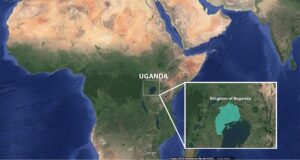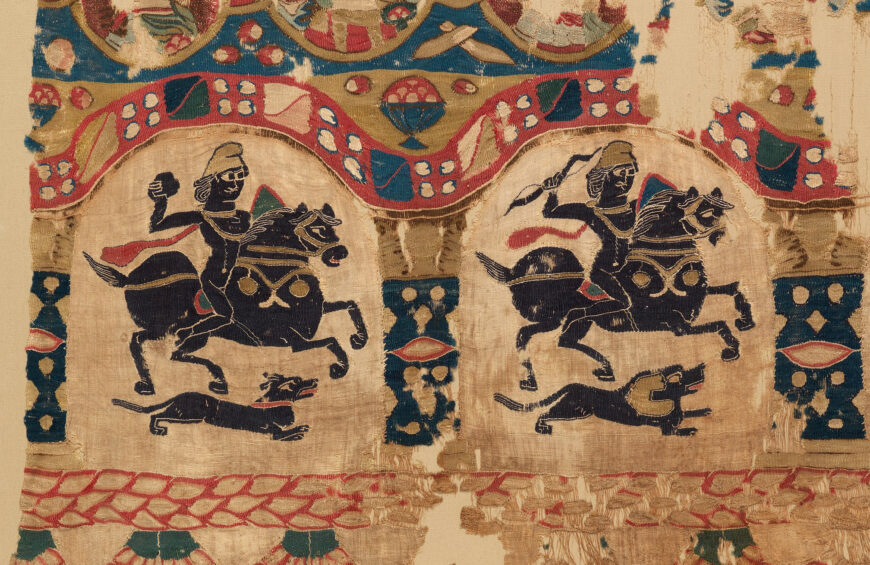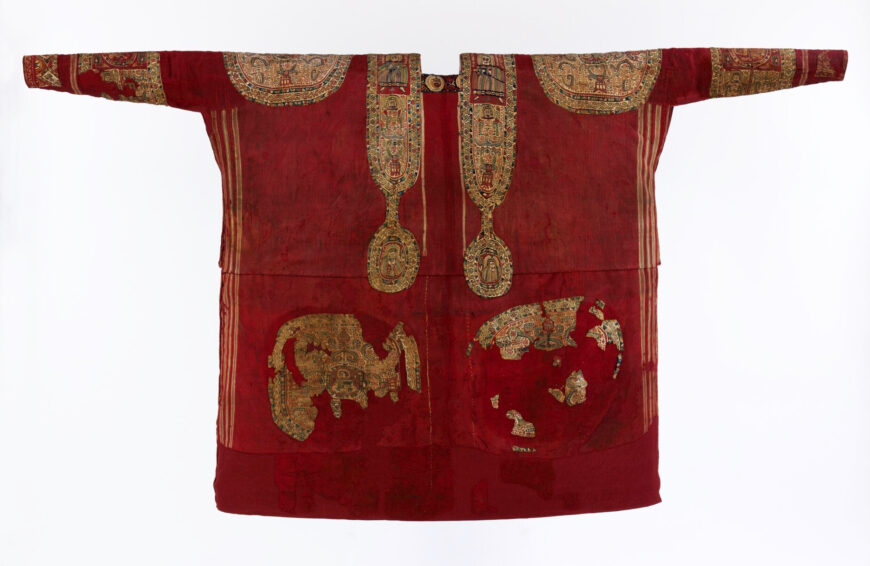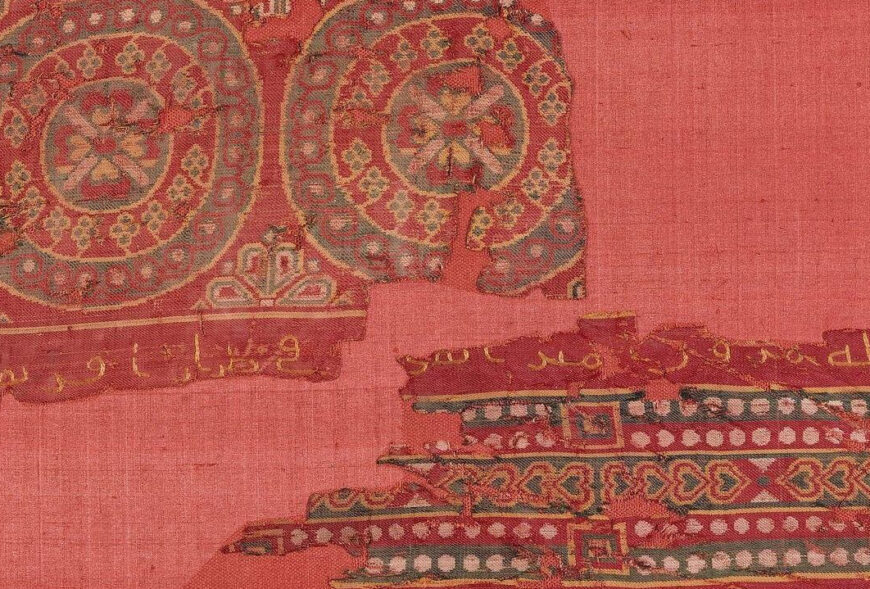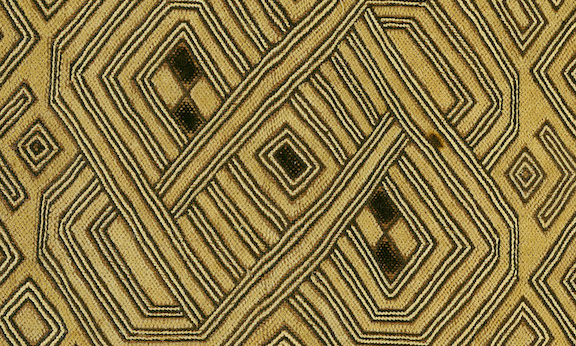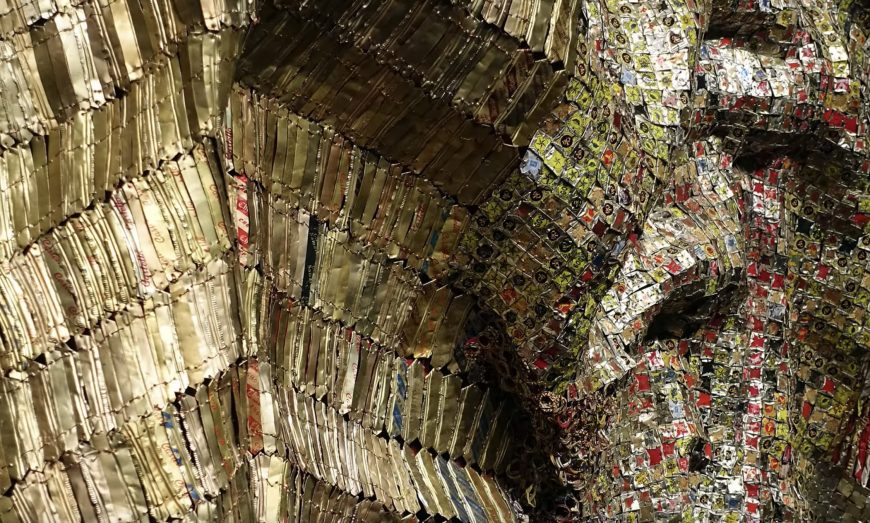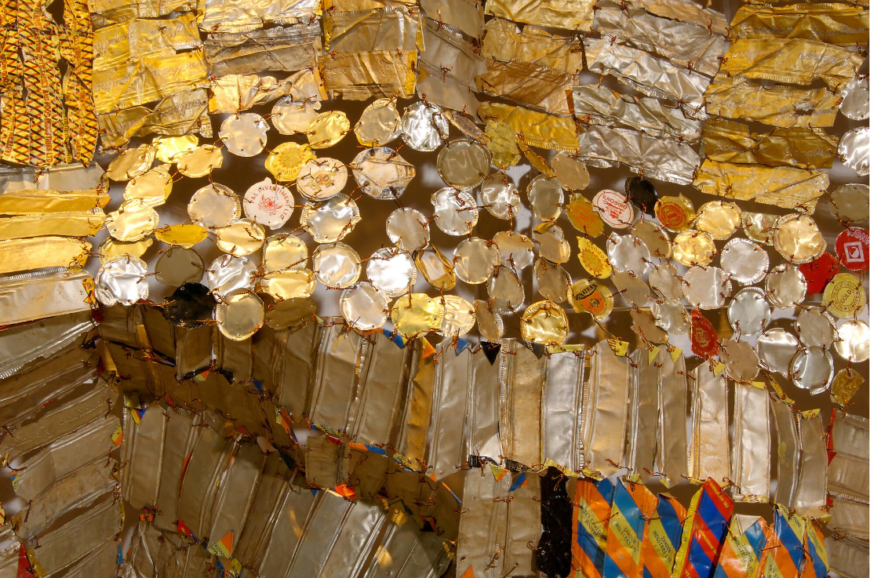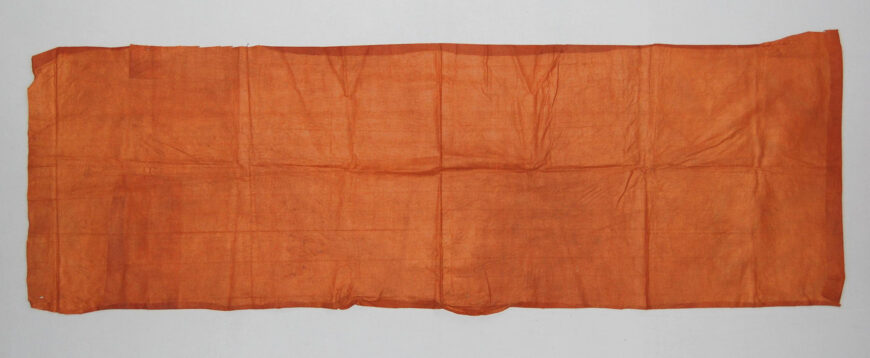
Barkcloth, acquisition details unknown, bark, 226 x 77 cm (© The Trustees of the British Museum, London)
In 2005, UNESCO announced barkcloth production in Uganda to be Intangible Cultural Heritage of Humanity. The Baganda people of the Kingdom of Buganda in present-day Uganda are the largest producers of barkcloth (olubugo) in the country. Barkcloth has been continuously created since the 18th century, though its origins may date back to the founding of the kingdom itself. [1]
Production of barkcloth: a sustainable practice
Barkcloth is made from the bark of mutuba trees. Men harvest the bark during the two rainy seasons, toggo (March to May) and ddumbi (September to December) by slicing two horizontal cuts into the tree a few meters apart. Then, one or two vertical cuts are made into the tree, joining the horizontal cuts. With great care, the bark is peeled off the tree, often with the use of a blunt knife or sharpened banana stem, and then the tree is wrapped with green banana leaves so that the trunk heals and grows its bark again (in about a year’s time).
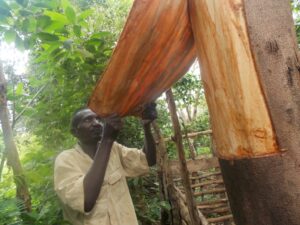
Final peeling off the bark skin from a tree for treatment in hot water, 2017 (photo: Joyce Nanjobe Kawooya, CC BY-NC-SA 4.0)
After the bark is harvested, it is softened through one of various methods, such as steaming (which can be achieved in different ways), dipping in a hot water bath, by burning the outer layer of the bark, or by keeping the bark moistened while it is being beaten. After the bark is softened, barkcloth makers spend several hours folding, stretching, and beating the bark. The size of the bark also plays a part in how long it takes the barkcloth maker to create the cloth.
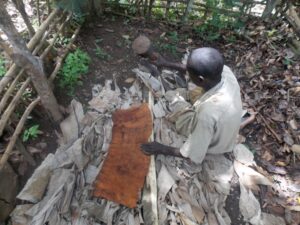
Stretching the treated bark skin to produce a barkcloth by hammering with a wooden mallet, 2017 (photo: Joyce Nanjobe Kawooya, CC BY-NC-SA 4.0)
The bark is beaten with a heavy mallet. The actual cloth is made from felting, a process in which the bark fibers are compressed and fused together. When the cloth is in its final stages of completion, barkcloth producers make adjustments, such as patching any tears or holes. Lastly, the barkcloth is stretched and left in the sun to dry for hours or days, which contributes to the final color of cloth. Generally, barkcloth that is considered the highest quality has a rich, red-brown color, and is soft.
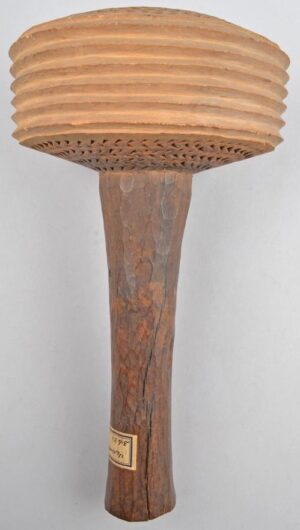
Barkcloth beater, acquired 1944 (Baganda people?), 27 x 14.20 x 12.70 cm (© The Trustees of the British Museum, London)
Uses of barkcloth
Barkcloth in the Kingdom of Buganda has been utilized for a variety of purposes. For everyday use, barkcloth was utilized for dress, especially for maintaining distinctions between members of royalty and commoners, as well as gender distinctions, and for storing valuable objects and for bedding. It was used for economic purposes, as a trade commodity, as tribute given to the kabaka (king) and chiefs, and as part of the dowry given by a man to the woman he wished to marry and to her family. It also played an important role in burials, as barkcloth was used for wrapping the bodies of people (both royals and commoners) who passed away, and for lining the walls of royal tombs and serving as a screen (to shield the deceased kabaka from public viewing). Barkcloth was and and continues to be used for ceremonial purposes, particularly for succession rites among royalty and commoners. The current king, Kabaka Ronald Mutebi II, was clothed in a barkcloth robe during his coronation in July 1993.
A royal cloth
Initially, the use of barkcloth was restricted to the kabaka, royals, and select royal servants (including chiefs, diviners, and court performers), but it was made available to commoners in the second half of the 18th century. It is believed that Kabaka Ssemakookiro, the reigning king at the time, mandated that all Baganda men participate in the cultivation of barkcloth trees and the creation of barkcloth. Barkcloth production then and today was undertaken by men, and it is a time-consuming process that requires people to work together.
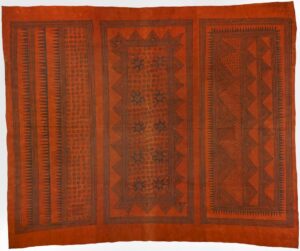
Barkcloth, 1930 (Baganda people), stenciled bark, 249 x 210 cm (© The Trustees of the British Museum, London)
The impacts of trade, religion, and colonization
Barkcloth production, and the meanings associated with barkcloth, changed drastically during the 19th and 20th centuries. For instance, Swahili-Arab traders who came to the Kingdom of Buganda in the mid-19th century introduced Islam to the royal court (which was declared the kingdom’s official religion in 1875), mat weaving (which was and is practiced by Baganda women), and woven textiles. As with barkcloth, the wearing of woven textiles was restricted to members of royalty and chiefs. [2]
In addition, Swahili-Arab traders influenced the development of patterned barkcloth. In the example above from the British Museum, the barkcloth contains three vertical rectangles that are outlined with several lines, and decorated inside with varying triangular, circular, and six-pointed star patterns. The barkcloth itself has a rich, rust color, and the patterning appears black. The dye used in barkcloth decoration is made from a local plant known as muzuukizi and iron slip. The dye is applied by painting with one’s fingers or by using a stencil made from a smoked banana leaf or banana fiber. After the decoration was complete, the barkcloth was set in the sun to dry, and the dye (which when dried forms a clay) was scraped off to reveal the painted or stenciled design. [3] Although patterned barkcloth was a new development, it was overshadowed by the increased importation of woven textiles.
The arrival of European missionaries in the latter half of the 19th century also had an impact on barkcloth production as well as attitudes towards it. These missionaries sought to convert the Baganda people from Islam and from indigenous beliefs and ritual practices to Christianity. Missionaries stigmatized the production and use of barkcloth, seeing it as entangled with indigenous beliefs and ritual practices. Due to the denigration of barkcloth by missionaries, Baganda Christians viewed (and continue to view today) barkcloth with mixed feelings. [4]
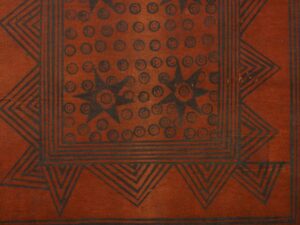
Triangle, circle, and star pattern (detail), Barkcloth, 1930 (Baganda people), stenciled bark, 249 x 210 cm (© The Trustees of the British Museum, London)
The Kingdom of Buganda and neighboring kingdoms were merged in 1894 to become the British Protectorate of Uganda. During this time, the power of kabaka was undermined and superseded by the British. Though the kabaka highly valued barkcloth, as he was its primary patron, the British administration did not share the kabaka’s view. Under British rule, the Baganda people were not obligated to give barkcloth as tribute to the kabaka. [5]
The British implemented a system of taxation that required the Baganda people to pay taxes to the colonial administration in three ways: by paying with rupees (the official currency of the Protectorate), by providing labor for building projects and growing cotton (which will be discussed shortly), and by paying with goods such as ivory, foodstuffs, and animal hides. Barkcloth was not a product that the British wanted. To pay taxes, some Baganda people traded barkcloth for other goods with the Bahima people in the neighboring Kingdom of Ankole. This trade in barkcloth not only helped to sustain barkcloth production, but it also revived the practice of barkcloth decoration, as patterned barkcloth was sought after by the Bahima people. The star pattern, seen on the barkcloth from the British Museum, is a symbol associated with the cosmology of the Bahima people. However, the demand for patterned barkcloth was again short-lived due to the increased availability of imported fabrics in the Protectorate.
Barkcloth production was obstructed when the British introduced cotton farming in 1902 to the Kingdom of Buganda. The cotton grown there was intended to supply the British textile industry. Colonial administrators, missionaries, and local chiefs who benefited from working with the colonial administration were instrumental in promoting (and even coercing) the Baganda people to cultivate cotton. Barkcloth production was set back, as the process of cultivating and harvesting cotton was time-consuming, and coincided with the harvesting of bark.
A symbol of allegiance and political protest
The wearing of barkcloth took on a different meaning towards the end of the British colonial rule: a symbol of allegiance to the kabaka and a symbol of protest against the colonial administration. Conflicts between the Kingdom of Buganda and the British administration resulted in the deportation of the kabaka and his court in 1953. Since the Baganda people viewed the deportation of the kabaka as tantamount to his death, they wore barkcloth to express their mourning for and loyalty to the king. The kabaka returned from exile in 1955, and Uganda gained independence from Britain in 1962.
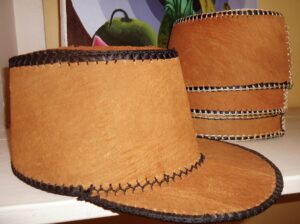
Local caps made from barkcloth, 2011 (photo: Ngumenawe, CC BY-NC-SA 4.0)
Barkcloth today
Despite efforts to discourage and disrupt the production and consumption of barkcloth in the 19th and 20th centuries, barkcloth continues to be made today. While it has been used for a variety of purposes historically, its utilization has expanded to create other products, like hats and caps (as seen above), handbags, belts, pillows, wall hangings, placemats, and car seat covers. Moreover, items made from barkcloth are sold in tourist and export markets.
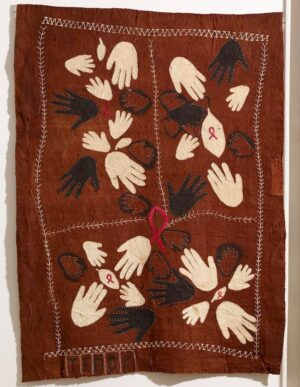
Teddy Nansekka, United For Life, felted, sewn, and pigmented bark, 142.50 x 105 cm (© The Trustees of the British Museum, London)
Barkcloth is also used for making artwork. For example, Teddy Nansekka’s United For Life consists of a hanging, rectangular piece of barkcloth. Against the rust-colored backdrop are three rectangular areas stitched with beige thread. Inside these rectangles are appliquéd beige and dark brown hands of varying sizes and beige leaves. There are also smaller hands (delineated with beige thread outlined with dark brown pigment) and sewn red ribbons alluding to contemporary concerns over HIV/AIDS. At the bottom left of the handing is the artist’s first name, with each letter dyed in dark brown and separated by beige thread.
The history of barkcloth production reflects cultural resilience, persistence, and dynamism, as it continues to be made, used, and adapted.


